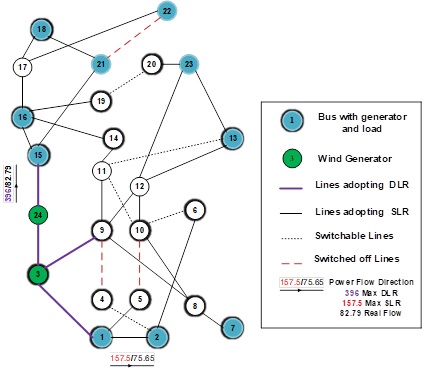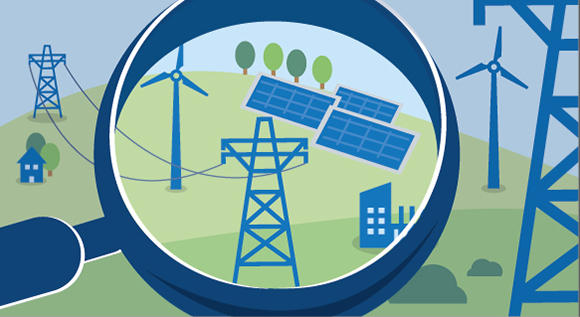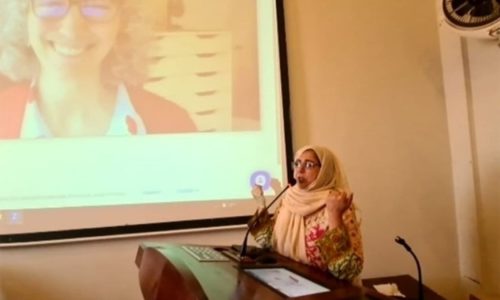In order to cope with the challenge of reducing CO2 emissions concerning climate change, many countries are increasing their renewable energy sources (RES) shares in their power system networks. However, the existing transmission network is not planned to accommodate such a large‐scale integration of RES. Therefore, the need for new transmission topologies to better utilize the existing transmission infrastructure is more demanding to be practically implemented.
An important consideration in the scheduling of power system is the accommodation of large‐scale wind power generation. Generally, wind farms are located far away from load locations. However, the transmission infrastructure in remote areas is relatively weak, which leads to transmission line congestion. Building new transmission lines is a lengthy process and needs considerable investment, which makes the transmission capacity of power system unable to accommodate the additional power from wind farms. As a result new cost‐effective and optimal control strategies are in demand to enhance renewable energy utilization efficiently in the presence of transmission line congestion.
A research team at NUST US-Pakistan Center for Advanced Studies in Energy (USPCAS-E), led by Dr. Muhammad Numan has explored the inherent flexibility of the transmission network for facilitating large-scale renewables integration into the grid. They developed a co-optimized optimal transmission switching (OTS) and dynamic line rating (DLR) model to efficiently utilize system resources by mitigating network congestion and maximizing RES integration. A new concept of flexible transmission dynamic line rating (FTDLR) is explored to deploy OTS in coordination with DLR as a control tool to utilize power system inherent flexibility. FTDLR is modeled in a stochastic unit commitment framework, which is used to dynamically increase the transmission line capacity based on the meteorological parameters and optimally select candidate lines to be switched from the network. The objective is to utilize system resources in conjunction with intermittent energy resources to improve economic efficiency of the network using the existing infrastructure. By solving the optimization model, enhanced computation with high fidelity formulations can be mobilized in order to boost the utilization efficiency of the system and postpone the need for building new transmission infrastructure. The network topology of the optimization problem with FTDLR for the RTS-24 network is illustrated in Figure 1.

Results published in [1] and [2] shows Substantial cost savings in both the system operating cost and wind curtailment costs. System dispatch cost is reduced up to 24.64% for the RTS-24 system while the cost savings for the IEEE 118-Bus system is 16.08%. The congestion rate in FTDLR is improved by 31.94% and 12.5% for RTS-24 and IEEE 118-Bus system respectively. It is showed that the application of FTDLR can improve the accommodation capacity of wind power into the system, especially when the capacity of the overhead transmission line is limited and system is congested. Wind curtailment savings for the modified RTS-24 and IEEE 118-Bus system are 60.47% and 89.85% respectively. Results indicated that only a small fraction of the network lines need to be switched off from the network and adopt DLR, which validates that the proposed model can be practically implemented in real-time operation of the power system with advancement in the smart grid technology.
References
[1] M. Numan, A. Z. Khan, M. Asif, S. M. Malik and K. Imran, “Exploiting the Inherent Flexibility in Transmission Network for Optimal Scheduling, Wind Power Utilization, and Network Congestion Management,” in IEEE Access, vol. 9, pp. 88746-88758, 2021, https://doi: 10.1109/ACCESS.2021.3090089
[2] M. Numan , F. Donghan , F. Abbas, S. Habib, S. Hao, Coordinated operation of reconfigurable networks with dynamic line rating for optimal utilization of renewable generation, International Journal of Electrical Power & Energy Systems, Volume 125, 2021, https://doi.org/10.1016/j.ijepes.2020.106473
The author is an Assistant Professor in the Department of Electrical Power Engineering at US-Pakistan Center for Advanced Studies in Energy (USPCAS-E), National University of Sciences and Technology (NUST) and can be reached at [email protected]





